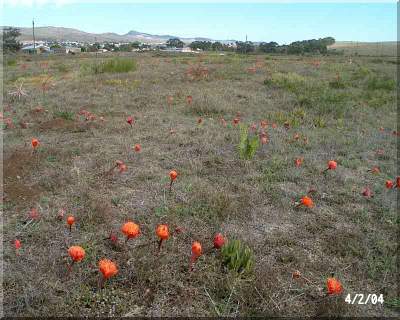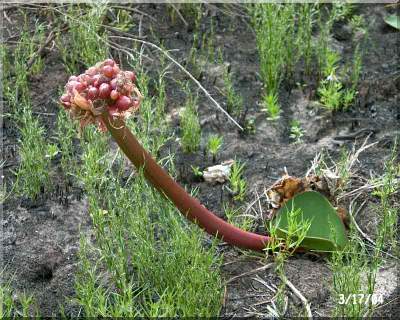

Haemanthus coccineus, Bredasdorp habitat, RSA
|
The
genus Haemanthus is endemic to Southern Africa. There are approximately
twenty-one species in the genus. This
genus may be summer growing, winter growing or evergreen.
The bulbs are medium to large bulbs, surrounded in a papery covering. The
flower is an umbel of many small flowers, surrounded by a large fleshy spathe
(a large bract between the flower and the leaf, which encloses the flower
cluster). Usually the flowers are produced before the leaves, except in the
evergreen species where leaves are present during the blooming period. The
flowers can be white or pink to red. The fruit is a soft, fleshy berry. After
removing the pulp from the seeds, the seeds can be planted directly into the
medium, gently pressing them into the medium, leaving some of the seed exposed. Haemanthus
species are best cultivated in a very well drained, raised bed or a large pot. You will
need a 30" pot for some of the larger species like H. sanguineus and H.
coccineus. Smaller species like H. crispus and H. unifolatus will grow well in a
20" pot for many years. Soil type and good drainage play a big role in how
your Haemanthus will grow. Certain species from desert/sandy regions like H.
namaquensis and H. norterii require a deep sandy medium to do well and a complete
dry rest during the dormancy period. H. coccineus can easily survive and do well
in the garden. H. montanus needs a winter rest and this rest needs to be dry
also. Haemanthus carneus in bloom at Mainly Amaryllids Garden. When
growing Haemanthus species that require shady or semi-sun positions like H.
carneus, H. humilis and H albiflos, use a potting mix with 50% sand
added to improved the texture of the soil. I have had excellent success
growing these species under shade-cloth (75%) and feeding well during
the growing season. More notes on this species and H. humilis can be
found here
Haemanthus coccineus, Napier, RSA
|

Haemanthus sanguineus, Brenton, RSA, in fruit
|
------------------------------------------------------------------------------------- ------------------------------------------------------------------------------------- The
following excerpts are taken from Cameron McMaster's Excerpt 1. The Interesting forms of Haemanthus in the Eastern CapeCameron and Rhoda McMaster
Email: At least five species of
this fascinating genus each with a number of forms and varieties, occur
in the Eastern Cape.
The most widespread is H. albiflos which is
amazingly adaptive and versatile in its habitat.
It is a particularly desirable and easy to grow garden subject
and is also suitable as a ground cover in areas of semi-shade.
It is equally at home in deep shade on forest floors, on rocky
sea shores exposed to salt spray, in coastal dune forest, on cliff faces
in hot river valleys where it clings in large clumps to crevasses in
full sun, and in shady places on high altitude inland mountain ranges.
It is evergreen and multiplies vegetatively, as well as from
seed. The attractive white
flowers appear in May and the ripe seeds are carried in equally
attractive clusters of scarlet fruit. Excerpt 2. Haemanthus montanus occurs in isolated local populations from the Eastern
Cape northwards and the Bedford district is probably its most southern
extremity. H. montanus grows
in small areas of poorly drained shallow soil with an impervious substratum.
It completes its annual cycle in four months, the period during
which......... Excerpt 3. H. humilis humilis has fairly round flat leaves, flowers in January and is deciduous. New leaves appear with the flowers and persist through to late spring. It occurs in isolated populations between rocks on steep cliff faces. The different populations are extremely variable with regard to size, the degree of hairiness and the colour of leaves and flowers. The most widespread is a medium sized pink form, very common on steep north facing krantzes in the Cathcart district. It was always a puzzle to us how many young plants became established on almost vertical places between the rock strata on cliffs. When handling ripe seed, we soon realised that this is due to fact that the seed is connected to sticky threads that enable it to adhere to virtually any surface and, under favourable conditions they become rooted seedlings. An
isolated population of H. humilis which has small grey hairy
leaves and cream flowers, occurs on the farm Keibolo in the Kei River
Valley growing under acacia trees in semi shade.
|